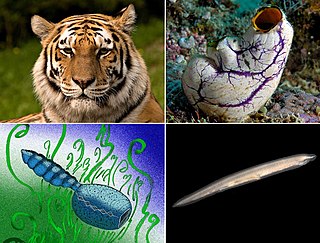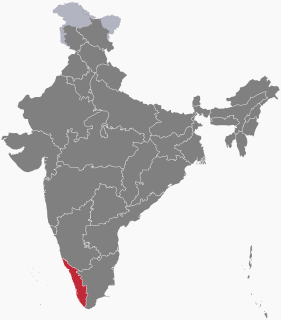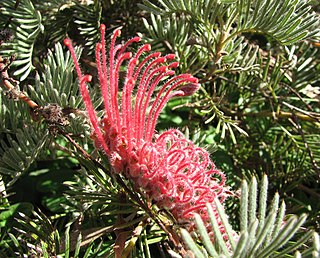Related Research Articles

A chordate is an animal of the phylum Chordata. All chordates possess 5 synapomorphies, or primary characteristics, at some point during their larval or adulthood stages that distinguish them from all other taxa. These 5 synapomorphies include a notochord, dorsal hollow nerve cord, endostyle or thyroid, pharyngeal slits, and a post-anal tail. Chordates get their name from their characteristic “notochord”, which plays a significant role in chordate structure and movement. Chordates are also bilaterally symmetric, have a coelom, possess a circulatory system, and exhibit metameric segmentation.
The Cambrian Period was the first geological period of the Paleozoic Era, and of the Phanerozoic Eon. The Cambrian lasted 55.6 million years from the end of the preceding Ediacaran Period 541 million years ago (mya) to the beginning of the Ordovician Period 485.4 mya. Its subdivisions, and its base, are somewhat in flux. The period was established as "Cambrian series" by Adam Sedgwick, who named it after Cambria, the Latin name for 'Cymru' (Wales), where Britain's Cambrian rocks are best exposed. The Cambrian is unique in its unusually high proportion of lagerstätte sedimentary deposits, sites of exceptional preservation where "soft" parts of organisms are preserved as well as their more resistant shells. As a result, our understanding of the Cambrian biology surpasses that of some later periods.

The Cyrillic script is a writing system used for various languages across Eurasia and is used as the national script in various Slavic, Turkic, Mongolic, Uralic and Iranic-speaking countries in Southeastern Europe, Eastern Europe, the Caucasus, Central Asia, North Asia and East Asia.

Dinosaurs are a diverse group of reptiles of the clade Dinosauria. They first appeared during the Triassic period, between 243 and 233.23 million years ago, although the exact origin and timing of the evolution of dinosaurs is the subject of active research. They became the dominant terrestrial vertebrates after the Triassic–Jurassic extinction event 201.3 million years ago; their dominance continued throughout the Jurassic and Cretaceous periods. The fossil record shows that birds are modern feathered dinosaurs, having evolved from earlier theropods during the Late Jurassic epoch, and are the only dinosaur lineage to survive the Cretaceous–Paleogene extinction event approximately 66 million years ago. Dinosaurs can therefore be divided into avian dinosaurs, or birds; and the extinct non-avian dinosaurs, which are all dinosaurs other than birds.
ISO 8601Data elements and interchange formats – Information interchange – Representation of dates and times is an international standard covering the exchange of date- and time-related data. It is maintained by the Geneva-based International Organization for Standardization (ISO) and was first published in 1988 with updates in 1991, 2000, 2004 and 2019. The purpose of this standard is to provide an unambiguous and well-defined method of representing dates and times, so as to avoid misinterpretation of numeric representations of dates and times, particularly when data is transferred between countries with different conventions for writing numeric dates and times.
The Jurassic is a geologic period and stratigraphic system that spanned from the end of the Triassic period 201.3 million years ago (Mya) to the beginning of the Cretaceous period, approximately 145 Mya. The Jurassic constitutes the middle period of the Mesozoic era and is named after the Jura Mountains, where limestone strata from the period were first identified.

Nuclear fusion is a reaction in which two or more atomic nuclei are combined to form one or more different atomic nuclei and subatomic particles. The difference in mass between the reactants and products is manifested as either the release or the absorption of energy. This difference in mass arises due to the difference in atomic binding energy between the nuclei before and after the reaction. Fusion is the process that powers active or main sequence stars and other high-magnitude stars, where large amounts of energy are released.

Malayalam is a Dravidian language spoken in the Indian state of Kerala and the union territories of Lakshadweep and Puducherry by the Malayali people. It is one of 22 scheduled languages of India and is spoken by 2.88% of Indians. Malayalam has official language status in Kerala, Lakshadweep and Puducherry (Mahé), and is spoken by 34 million people worldwide. Malayalam is also spoken by linguistic minorities in the neighbouring states; with significant number of speakers in the Kodagu and Dakshina Kannada districts of Karnataka, and Nilgiris and Kanyakumari, districts of Tamil Nadu. Due to Malayali expatriates in the Persian Gulf, Malayalam is also widely spoken in the Gulf countries.

Kannada is a Dravidian language spoken predominantly by the people of Karnataka in the southwestern region of India. The language is also spoken by linguistic minorities in the states of Maharashtra, Andhra Pradesh, Tamil Nadu, Telangana, Kerala and Goa; and also by Kannadigas abroad. The language had roughly 43 million native speakers by 2011. Kannada is also spoken as a second and third language by over 12.9 million non-native speakers in Karnataka, which adds up to 56.9 million speakers. It is one of the scheduled languages of India and the official and administrative language of the state of Karnataka. Kannada was the court language of some of the most powerful empires of South and Central India, such as the Chalukya dynasty, the Rashtrakuta dynasty, the Vijayanagara Empire and the Hoysala Empire.
Hard rock or heavy rock is a loosely defined subgenre of rock music typified by a heavy use of aggressive vocals, distorted electric guitars, bass guitar, and drums, sometimes accompanied with keyboards. It began in the mid-1960s with the garage, psychedelic and blues rock movements. Some of the earliest hard rock music was produced by the Kinks, the Who, the Rolling Stones, the Yardbirds, Cream and the Jimi Hendrix Experience. In the late 1960s, bands such as the Jeff Beck Group, Iron Butterfly, the Beatles, Led Zeppelin, Golden Earring, Steppenwolf and Deep Purple also produced hard rock.

The modern English alphabet is a Latin alphabet consisting of 26 letters, each having an upper- and lower-case form. It originated around the 7th century from Latin script. Since then, letters have been added or removed to give the current Modern English alphabet of 26 letters with no diacritics, digraphs, and special characters. The word alphabet is a compound of the first two letters of the Greek alphabet, alpha and beta.

Grevillea thyrsoides is a small, spreading shrub which is endemic to Western Australia. It grows to between 0.3 metres and 0.7 metres in height and is up to 1.5 metres in width. It produces red flowers in late summer to early autumn and mid-winter to early spring

Grevillea crithmifolia is a shrub which is endemic to the south west region of Western Australia.

Grevillea pilosa is a low growing shrub which is endemic to the south-west of Western Australia. It grows to between 0.4 and 1 metre in height and produce red or pink flowers between June and December in its native range.

Grevillea erectiloba is a shrub which is endemic to Western Australia. It usually grows to a height of between 1 and 3 metres and produces red flowers between September and October in its native range.

Grevillea drummondii, or Drummond's grevillea, is a shrub which is endemic to the south west region of Western Australia.

Xylomelum angustifolium, the sandplain woody pear, is a tree species in the family Proteaceae, endemic to Western Australia. A mature Xylomelum angustifolium grows from 2 to 7 metres, though trees up to 10m have been observed. Produces cream flowers between December and February though flowering can commence as early as September in its northern range.

The COVID-19 pandemic, also known as the coronavirus pandemic, is an ongoing global pandemic of coronavirus disease 2019 (COVID-19), which is caused by severe acute respiratory syndrome coronavirus 2 (SARS-CoV-2). The virus was first identified in December 2019 in Wuhan, China. The World Health Organization declared a Public Health Emergency of International Concern regarding COVID-19 on 30 January 2020, and later declared a pandemic on 11 March 2020. As of 18 June 2021, more than 177 million cases have been confirmed, with more than 3.84 million confirmed deaths attributed to COVID-19, making it one of the deadliest pandemics in history.

Coronavirus disease 2019 (COVID-19) is a contagious disease caused by severe acute respiratory syndrome coronavirus 2 (SARS-CoV-2). The first known case was identified in Wuhan, China in December 2019. The disease has since spread worldwide, leading to an ongoing pandemic.

COVID-19 vaccination in Kazakhstan is an ongoing immunization campaign against severe acute respiratory syndrome coronavirus 2 (SARS-CoV-2), the virus that causes coronavirus disease 2019 (COVID-19), in response to the ongoing pandemic in the country.
References
- 1 2 Sepkoski, Jack (2002). "A compendium of fossil marine animal genera". Bulletins of American Paleontology. 364: 560. Archived from the original on July 23, 2011. Retrieved 2009-02-27.
- ↑ "Clupeiformes". Paleobiology Database. Retrieved November 18, 2012.
